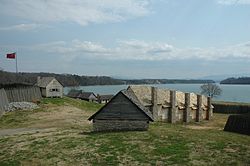
The following is a list of forts in the U.S. state of Tennessee .

The following is a list of forts in the U.S. state of Tennessee .



| Name | County | Built | Notes |
|---|---|---|---|
| 05 Fort Adair | Knox | 1788 or 1791 | Location unknown, destroyed |
| 10 Fort Assumption | Shelby | 1739 | |
| 15 Bledsoe's Fort | Sumner | 1781–83 | |
| 20 Fort Blount | Jackson | 1794 | Site excavated 1989–1994 |
| 20 Camp Boone | Montgomery | 1861 | |
| 25 Fort Cass | Bradley | 1835 | |
| 25 Fort Defiance | Montgomery | 1861 | a multi-million dollar museum and interpretive center construction began 2010. |
| 30 Fort Donelson | Stewart | 1861 | |
| 35 Fort Henry | Henry and Stewart | 1861 | |
| 40 Fort Loudoun | Monroe | 1756 | |
| 45 Fort Nash | Coffee | 1793 | Structure destroyed. Site located on private property. |
| 45 Fort Nashborough | Davidson | 1781 | |
| 50 Fort Negley | Davidson | 1862 | |
| 55 Fort Pillow | Lauderdale | 1861 | |
| 60 Fort Prudhomme | Lauderdale, Shelby or Tipton | 1682 | Location unknown, destroyed |
| 65 Fort Randolph | Tipton | 1861 | Destroyed |
| 70 Fort Sanders | Knox | 1861 | |
| 75 Fort Southwest Point | Roane | 1797 | |
| 80 Tellico Blockhouse | Monroe | 1794 | |
| 85 Fort Watauga | Carter | 1775 | |
| 90 White's Fort | Knox | 1786 | |
| 95 Fort Wright | Tipton | 1861 | Only powder magazine left |